Ultimate Vegan Peanut Butter Stuffed Chocolate Cookies: Chewy, Gooey, and Irresistibly Delicious
Prepare for an extraordinary treat that will tantalize your taste buds! These vegan peanut butter stuffed chocolate cookies are truly the ultimate indulgence. Imagine sinking your teeth into a soft, intensely chewy dark chocolate cookie, only to discover a warm, rich, and delightfully gooey peanut butter center. It’s a flavor and texture combination so heavenly, you’ll find it impossible to stop at just one.
Despite their incredibly decadent appearance and taste, these cookies are surprisingly straightforward to prepare. Using readily available, simple ingredients, you can whip up a batch of these addictively good cookies that are sure to impress even the most discerning dessert lovers.
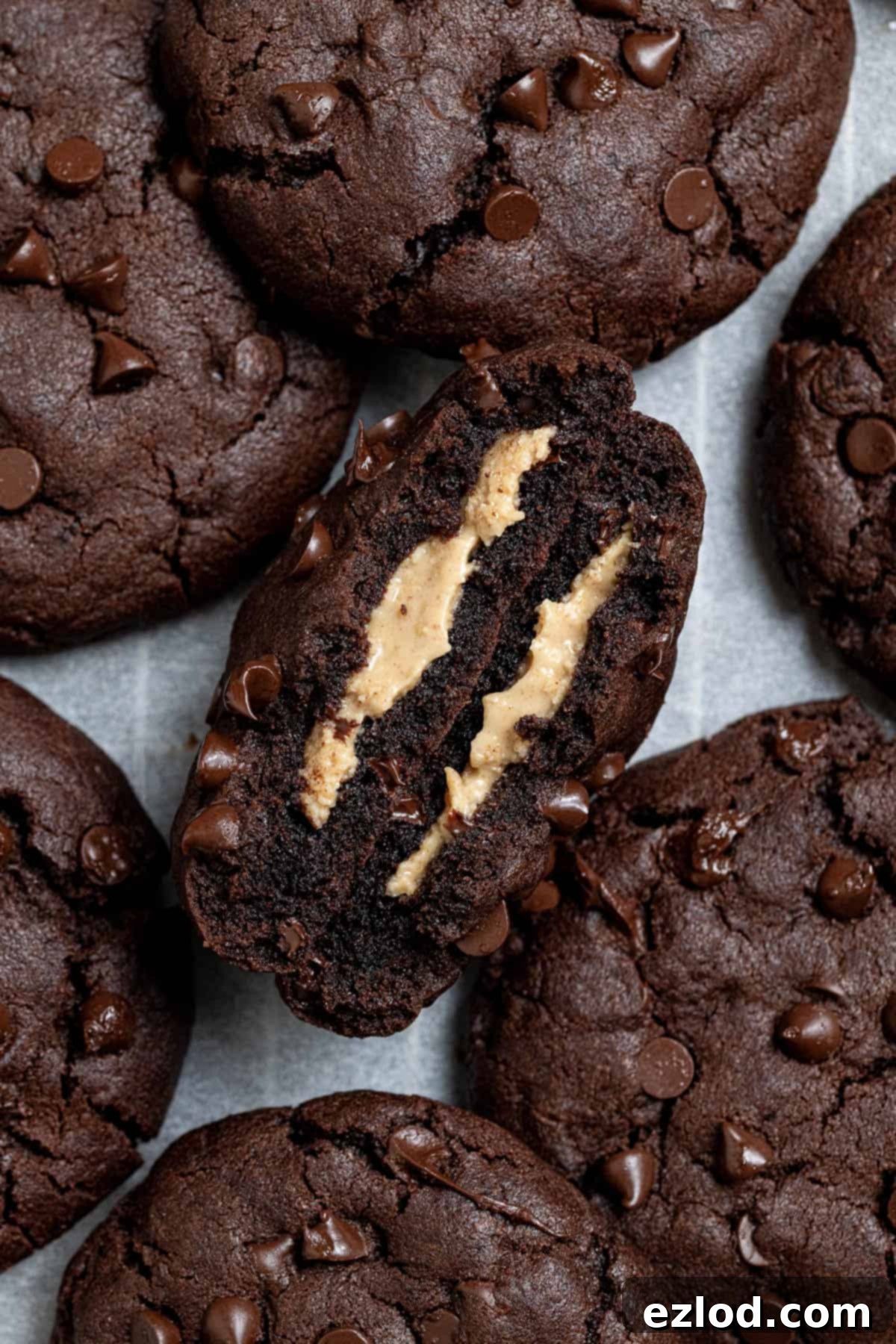
These vegan peanut butter stuffed chocolate cookies have quickly become a new favorite in my kitchen. The exquisite pairing of a deeply rich, dark chocolate cookie with a warm, slightly salty, and utterly gooey peanut butter filling creates a symphony of flavors that is pure bliss. They are particularly magical when enjoyed while still slightly warm, allowing that luxurious peanut butter core to remain beautifully melty and soft.
Many recipes for peanut butter stuffed cookies suggest adding sugar to the peanut butter filling. However, I’ve found that keeping the filling pure, 100% peanut butter prevents the cookies from becoming overly sweet, allowing the chocolate and peanut butter flavors to shine balancedly. My testing with a peanut butter and icing sugar filling resulted in cookies that were not only excessively sweet but also had a claggy, rather than gooey, texture in the center. This approach does mean that selecting the right type of peanut butter is crucial: you must use a thick, creamy variety, as natural, runnier peanut butter simply won’t hold its shape when rolled into balls.
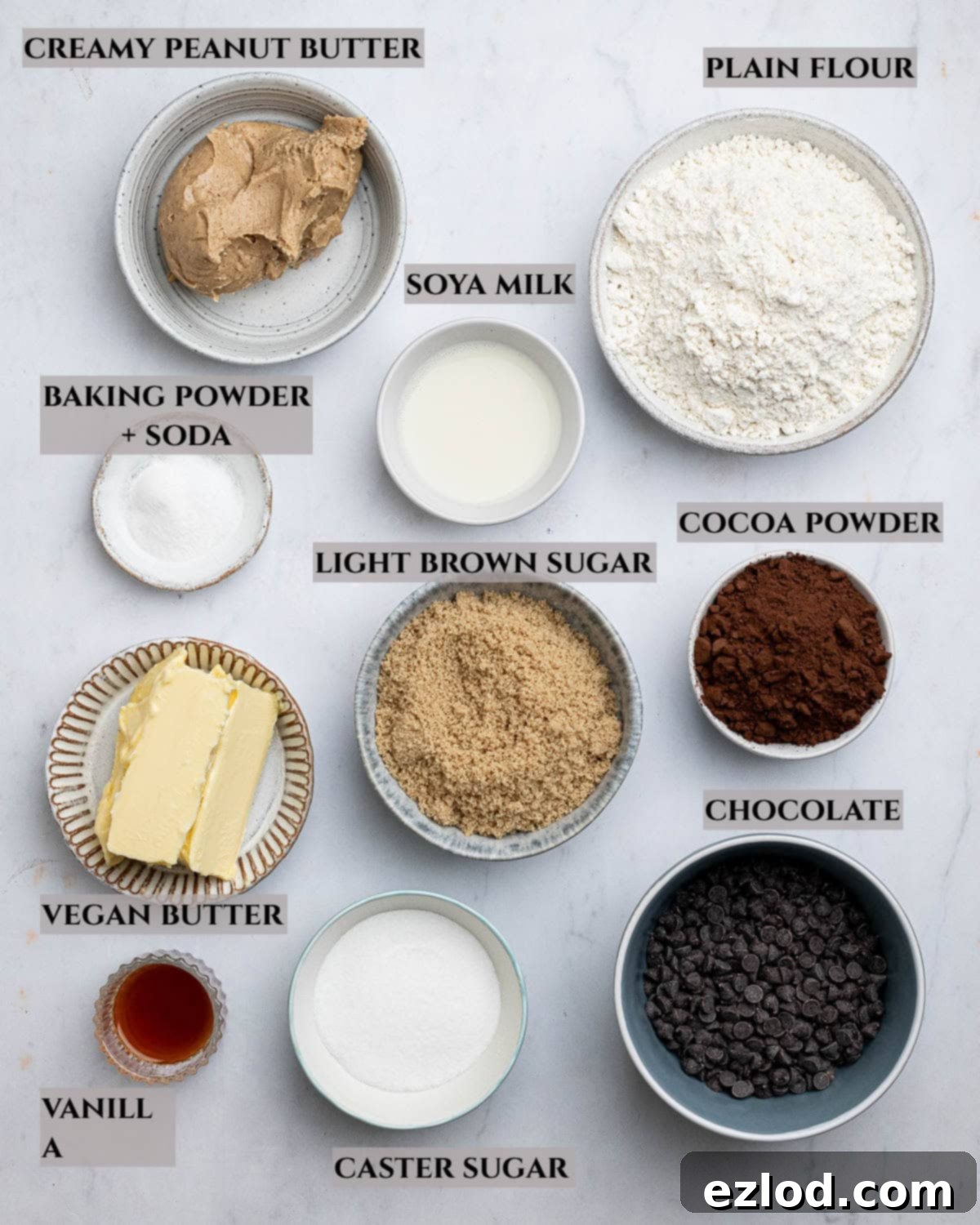
Essential Ingredient Insights: Crafting the Perfect Vegan Peanut Butter Stuffed Cookies
Understanding the role of each ingredient is key to achieving the perfect texture and flavor for these indulgent cookies. Here’s a breakdown of what you’ll need and why specific types are recommended:
Peanut Butter: This is a critical component, and the type you choose will significantly impact the outcome. It is absolutely essential to use a thick, creamy peanut butter – steer clear of natural varieties that contain only 100% peanuts. Natural peanut butter is typically too runny and will not hold its shape when rolled into balls, leading to a messy filling. Look for brands that include a stabilizer like palm oil, which gives it that firm, spreadable consistency. Since we’re not adding sugar to the filling, the peanut butter needs to be thick enough on its own to form stable balls. Both smooth and crunchy thick peanut butter will work perfectly; I personally find Whole Earth smooth peanut butter delivers excellent results.
Vegan Butter: For superior cookie texture, please use a block-style vegan butter or margarine, rather than the spreadable kind typically found in tubs. Block butter contains less water and a higher fat content, which is crucial for achieving a chewy, firm cookie dough. Spreadable varieties have too much water, which can result in a softer, more cake-like cookie texture that may spread excessively during baking.
Baking Powder and Bicarbonate of Soda (Baking Soda): The combination of these two leavening agents is intentional and crucial for the ideal cookie texture. Baking powder generally contributes to a taller, softer, and slightly more cakey cookie, while bicarbonate of soda reacts with the cocoa powder to create a chewier, denser, and slightly craggier cookie with a richer brown color. Using a precise mix of both ensures you get the best of both worlds: a cookie that is chewy, soft, and perfectly risen.
Non-Dairy Milk: In this vegan recipe, non-dairy milk serves as a vital moisture source, effectively replacing the liquid that an egg would typically provide. While most unsweetened non-dairy milks (such as almond, oat, or rice milk) can be used, I highly recommend opting for soy milk if possible. Soy milk boasts a higher protein content compared to other plant-based milks, making it the closest functional substitute for egg in terms of binding and texture contribution.
Plain Flour (All-Purpose Flour): Standard plain or all-purpose flour is the best choice for these cookies, providing the necessary structure and chewiness. I have not experimented with gluten-free flour blends for this recipe, so I cannot guarantee the same results if you choose to make a gluten-free version.
Chopped Chocolate: While chocolate chips (as seen in some photos) are certainly convenient, I strongly recommend using roughly chopped dark chocolate for the most exceptional cookies. Chopped chocolate creates delightful pockets of molten chocolate that spread beautifully throughout the cookie as it bakes. The choice between dark or vegan milk chocolate is yours, but I generally lean towards dark chocolate, as the cookies are already quite sweet, and the slight bitterness of dark chocolate provides a lovely balance.
Sugar: The blend of two types of sugar is another secret to the perfect cookie texture. White sugar (caster or granulated) contributes to thin, crisp edges and helps with spread, while brown sugar (light brown soft sugar is preferred over dark) adds moisture, chewiness, and depth of flavor. This combination ensures a cookie that is moist in the center with a delightful chew.
Cocoa Powder: For the richest chocolate flavor and proper leavening, it’s important to use Dutch-processed cocoa powder, not natural cocoa powder. Dutch-processed cocoa has been treated to reduce its acidity, resulting in a darker color and a smoother, less bitter chocolate taste, which pairs perfectly with the bicarbonate of soda in this recipe.
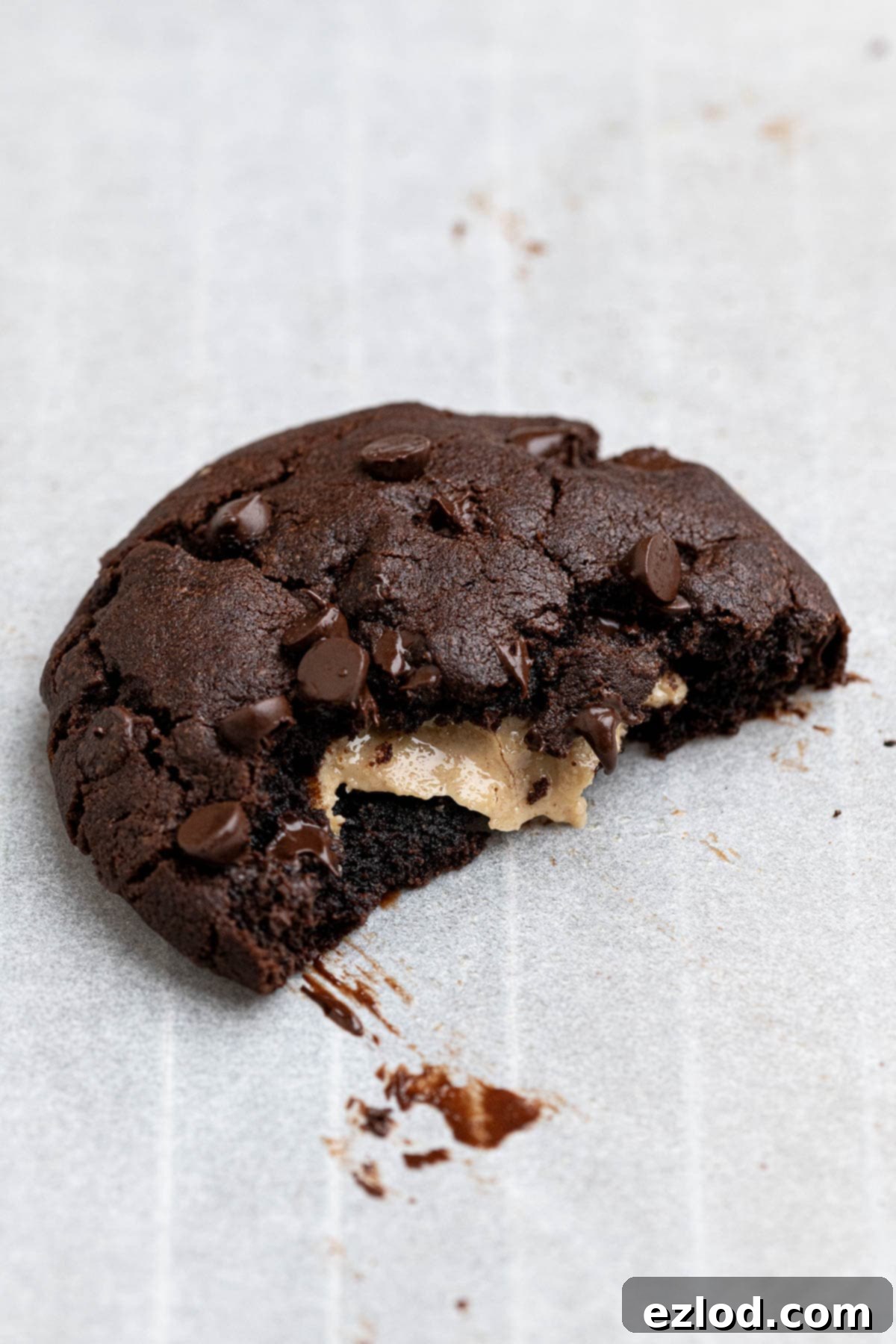
How To Master Peanut Butter Stuffed Chocolate Cookies: Step-by-Step Guide
(For precise measurements and detailed instructions, refer to the complete recipe card located at the bottom of this page.)

- Step 1: Prepare Peanut Butter Balls. Begin by shaping your thick, creamy peanut butter into 12 small, roughly uniform balls. Don’t worry about them being perfectly neat. Arrange them on a small tray lined with baking paper and place them in the freezer for at least 30 minutes to firm up. This freezing step is crucial for easy handling when stuffing the cookies.

- Step 2: Cream Butter and Sugars. In a large mixing bowl, cream together the softened vegan block butter, light brown soft sugar, and caster/granulated sugar using an electric mixer until the mixture is light, fluffy, and smooth. This process incorporates air and dissolves the sugars, contributing to the cookie’s texture.
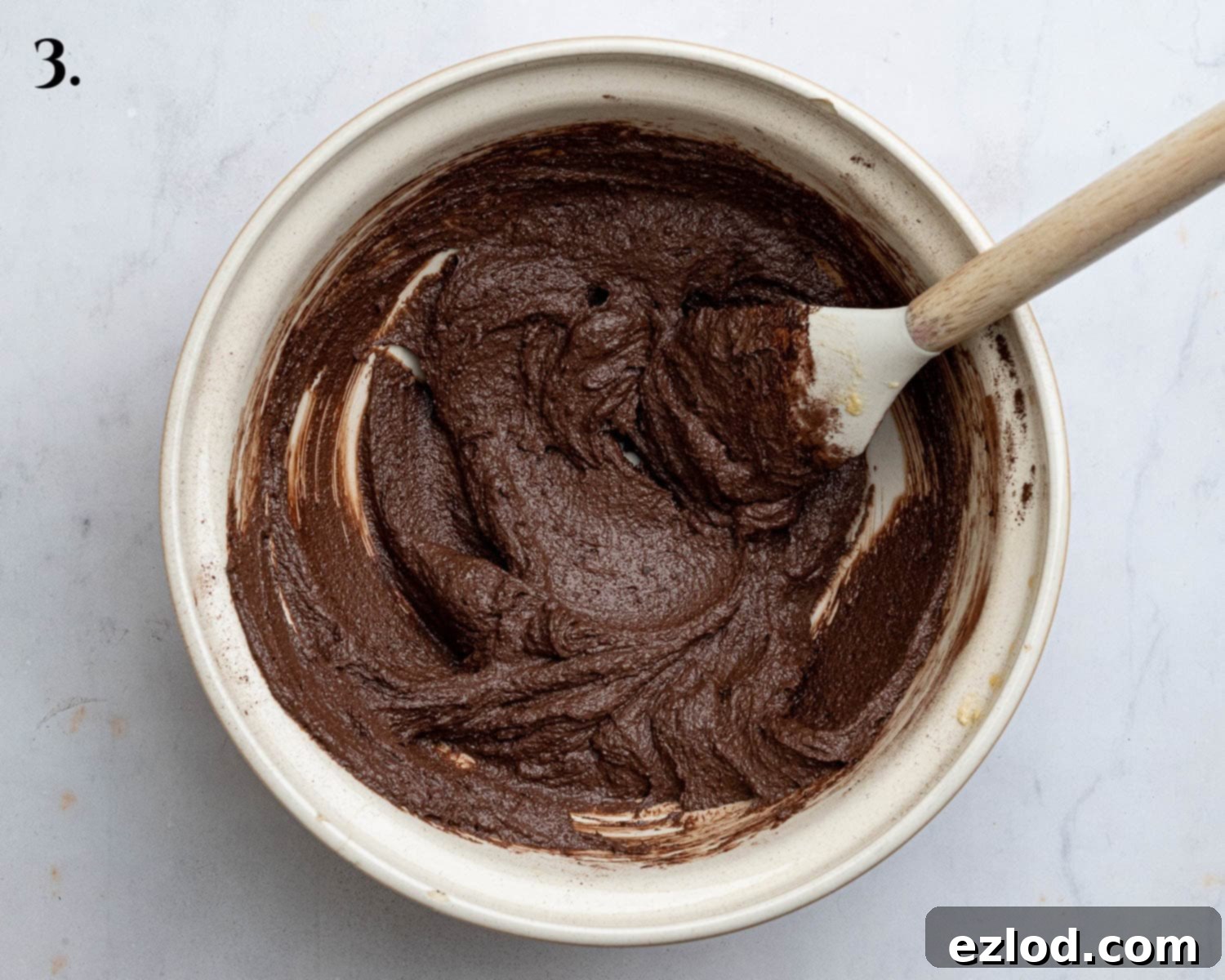
- Step 3: Add Wet Ingredients and Cocoa. To the creamed butter and sugar mixture, add the non-dairy milk, vanilla extract, salt, baking powder, bicarbonate of soda, and Dutch-processed cocoa powder. Beat again with the electric mixer until all ingredients are well combined and the mixture is smooth and evenly colored, forming a dark chocolate base.
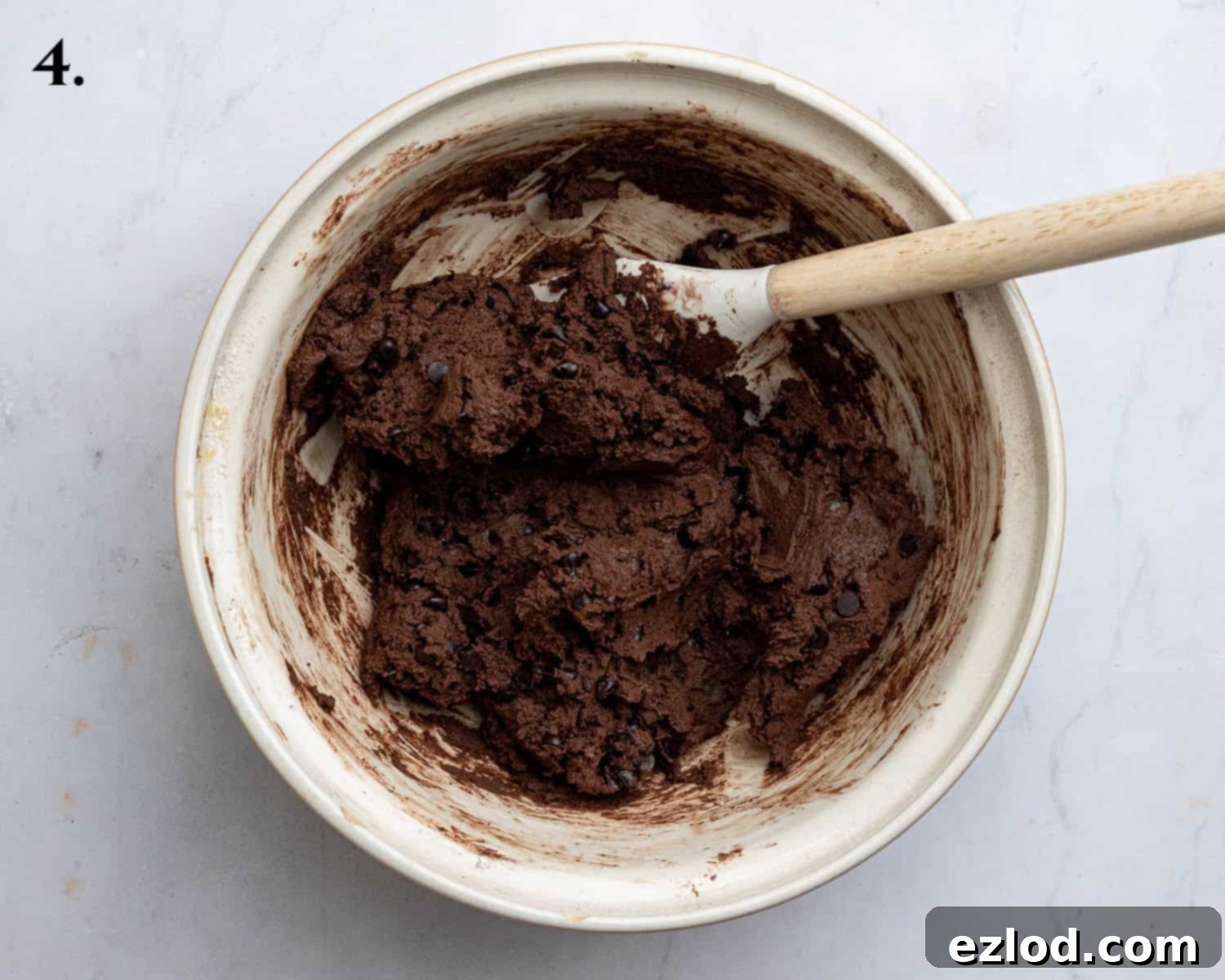
- Step 4: Incorporate Flour and Chocolate. Gradually add the plain flour to the wet mixture, stirring gently until no dry patches of flour remain. Be careful not to overmix. Then, fold in the chopped dark chocolate chunks (reserving a few for topping) until evenly distributed. Cover the bowl and chill the dough in the fridge for at least 30 minutes. This chilling step prevents spreading and enhances flavor.
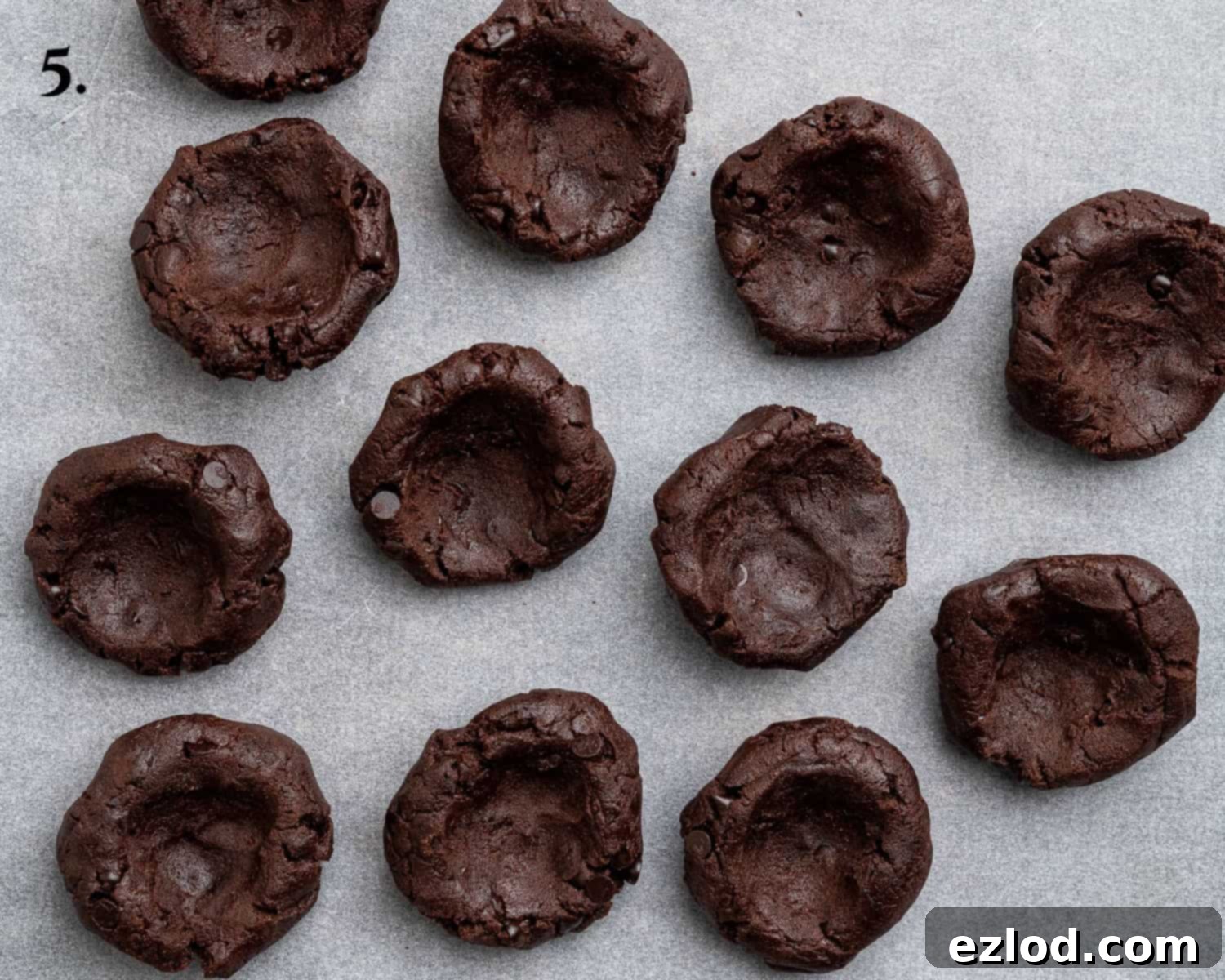
- Step 5: Shape Cookie Dough. After chilling, divide the cookie dough into 12 equal portions. For best accuracy, use a kitchen scale. Roll each portion into a smooth ball, then use your thumbs or a small spoon to create a deep indentation in the center of each dough ball. This hollow will house the peanut butter filling.
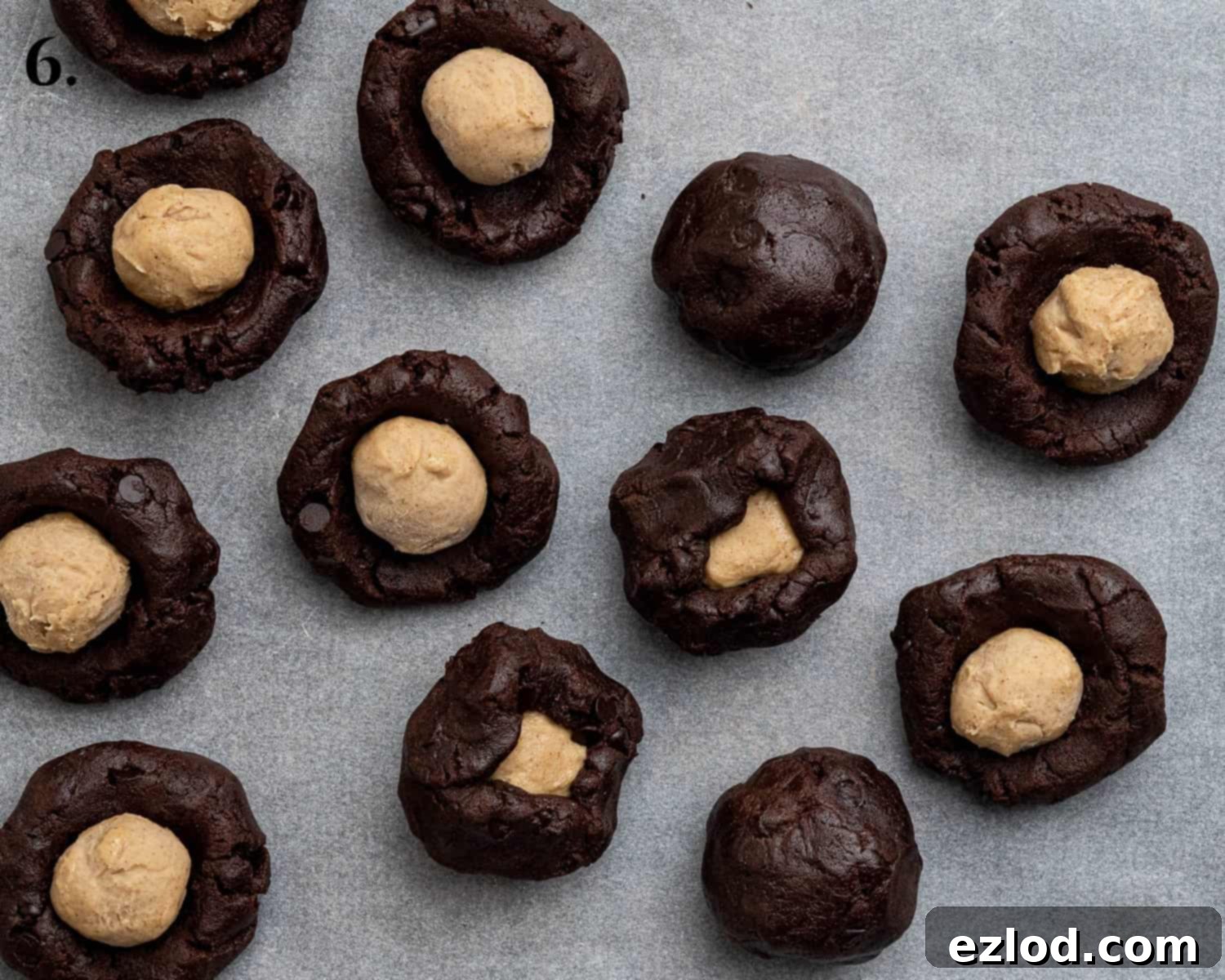
- Step 6: Stuff and Seal. Take one of the frozen peanut butter balls and place it firmly into the indentation of a cookie dough ball. Carefully use your hands to mold the cookie dough around the peanut butter, ensuring it is completely encased with no peanut butter visible. This creates a perfect, sealed center for that gooey surprise.

- Step 7: Prepare for Baking. Arrange the stuffed cookie dough balls well spaced apart on two baking sheets lined with parchment paper. Press a few pieces of the reserved chocolate chunks onto the top of each cookie dough ball for an aesthetically pleasing finish, but avoid flattening the balls.
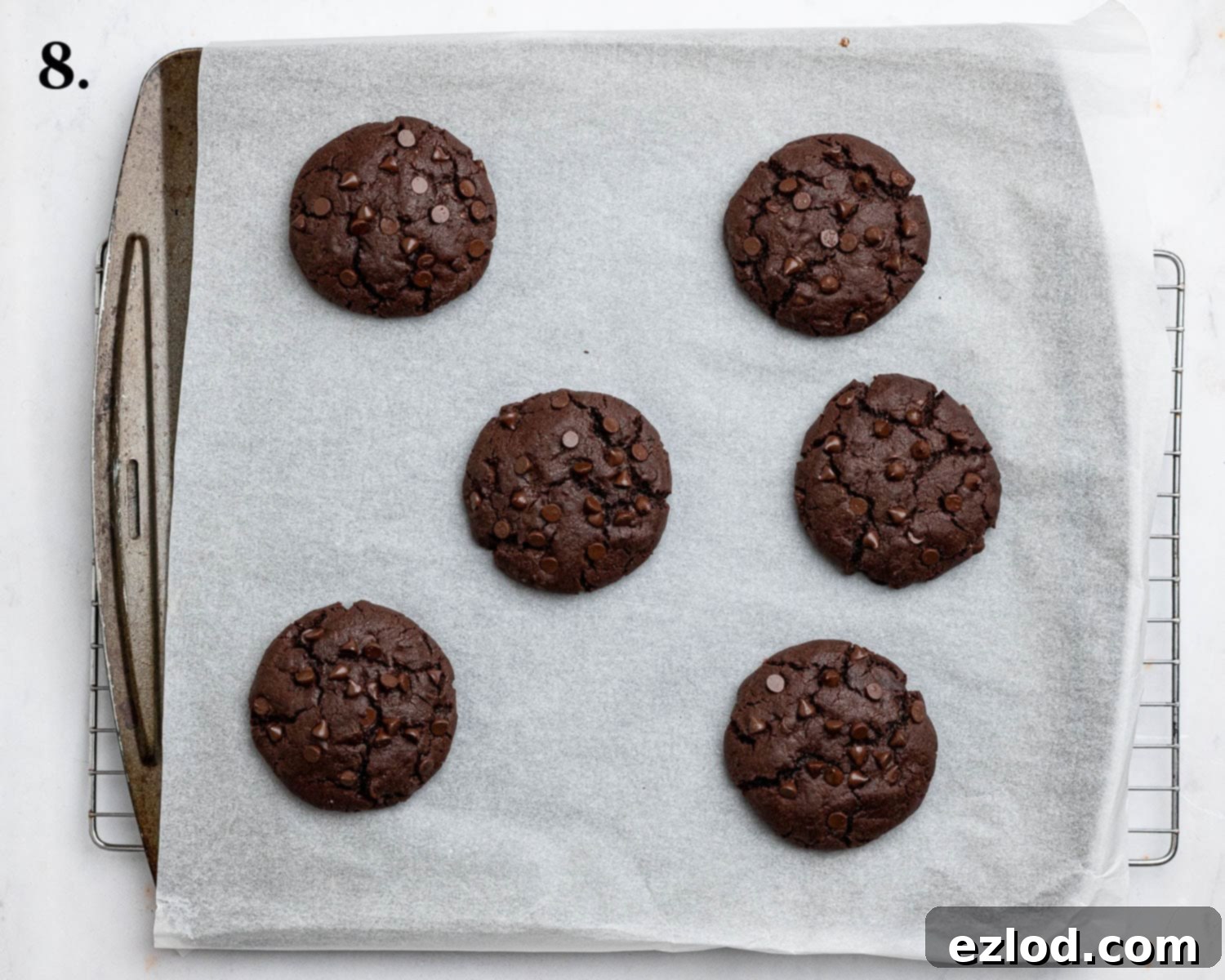
- Step 8: Bake. Preheat your oven to 180°C/160°C fan/350°F/gas mark 4. Bake the cookies for 12-15 minutes, or until the edges appear just firm but the centers still look soft. Remember, cookies will continue to set and firm up as they cool, so underbaking slightly is often preferable for a chewier result.
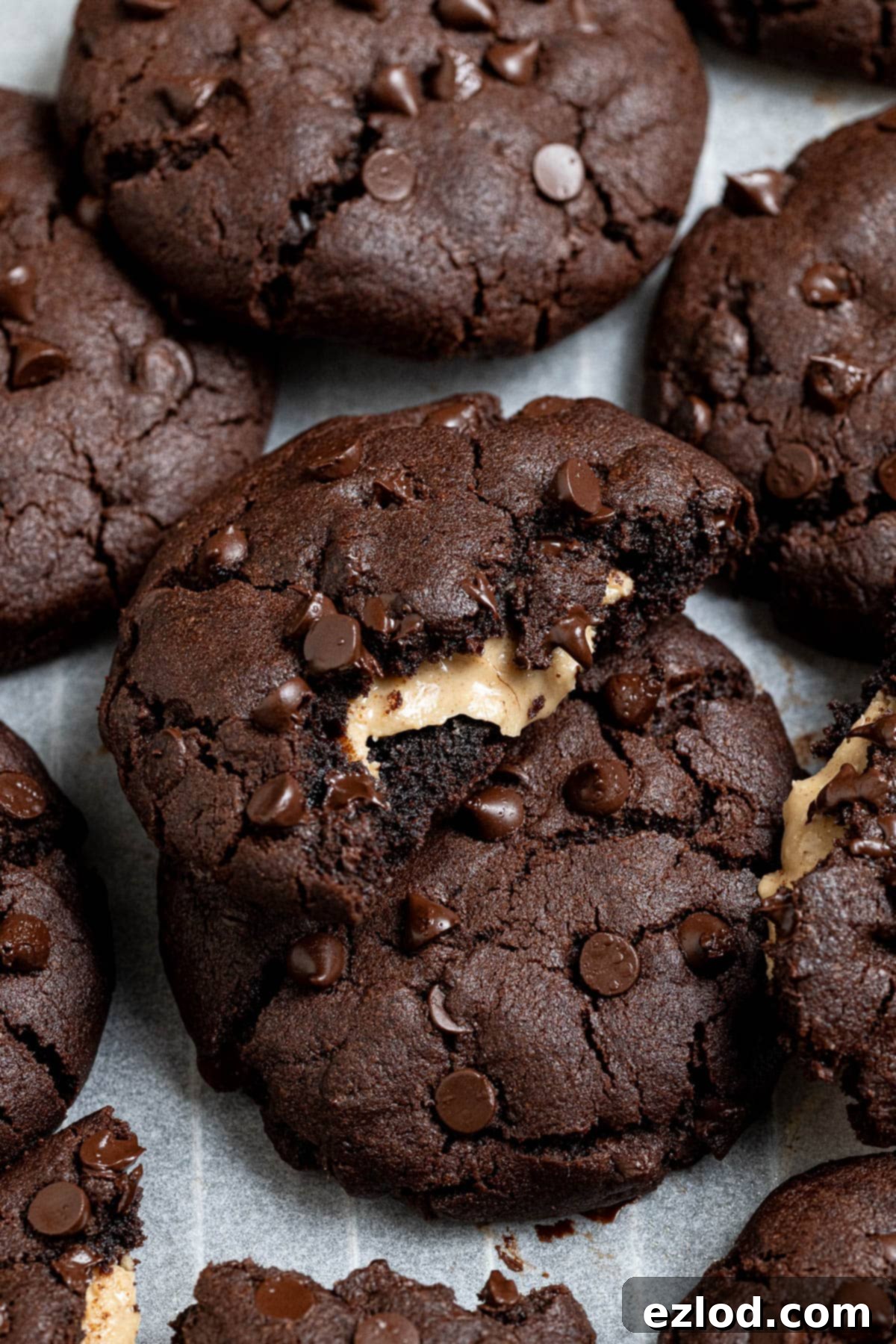
Expert Tips for Perfect Vegan Stuffed Cookies
Achieving bakery-quality vegan stuffed cookies is easier than you think with these essential tips:
For the absolute best results, precision is paramount in baking. I cannot stress enough the importance of weighing your ingredients using gram measurements with a digital kitchen scale, rather than relying on cup conversions. Cup measurements are inherently less accurate and can vary significantly depending on how ingredients are packed, which can drastically alter the final texture of your cookies. A gram is always a consistent unit of measure, ensuring reproducibility.
Similarly, for tablespoon and teaspoon measurements, always use proper measuring spoons. Standard kitchen spoons are not calibrated and will give inaccurate amounts. A level Tablespoon is 15ml, and a level teaspoon is 5ml – avoid heaped measurements unless specified.
Cookies, while seemingly simple, can be quite sensitive to minor changes. Any deviation from the recipe or the exact ingredients specified can have a notable impact on the texture, spread, and overall outcome. For this reason, I strongly recommend following the recipe precisely as written, especially if it’s your first time making them.
If you only have natural peanut butter (made from 100% peanuts) on hand, you’ll need to adjust it to achieve the necessary thickness for the filling. Mix in approximately 50g (about ½ cup) of icing (powdered) sugar until it becomes firm enough to shape into balls. Be aware this will add sweetness to the filling.
For cookies that look as good as they taste, remember to save a few of those chopped chocolate chunks. Before baking, gently press these reserved pieces onto the tops of your formed cookie dough balls. This ensures you’ll have beautiful, melted chocolate pools visible on the surface of the baked cookies.
Always bake these cookies on a metal baking sheet. Unlike glass dishes or silicone mats, metal baking sheets conduct heat efficiently and evenly, promoting proper browning and crisping on the bottom, which is vital for the desired texture. Glass or silicone can lead to uneven baking and a cakier result.
Once baked, allow your cookies to cool on the hot baking sheet for at least 10 minutes before attempting to transfer them. Cookies are quite fragile and soft when hot, and moving them too soon can cause them to break apart. After 10 minutes, they will have firmed up enough to be safely transferred to a wire rack to cool completely. This cooling process on the rack is also important for air circulation, which prevents sogginess and helps them set properly.
Frequently Asked Questions About Vegan Peanut Butter Stuffed Chocolate Cookies
Once fully cooled, the baked vegan peanut butter stuffed chocolate cookies can be stored in an airtight container at room temperature for 3-4 days. While they are certainly enjoyable for several days, they are undoubtedly at their absolute best when eaten on the day they are baked, especially if warmed slightly to soften that peanut butter core.
Absolutely! Both the cookie dough and the peanut butter balls can be prepared ahead of time. The chocolate cookie dough will keep well in the fridge for up to 4 days, provided it’s tightly covered to prevent drying out. Similarly, the peanut butter balls can be frozen for up to 4 days, ensuring they are well-covered. For maximum convenience, you can even fully assemble and shape the cookies, then freeze them spaced apart on a tray until solid. Once frozen, transfer them to a freezer bag or airtight container and store for up to three months. When ready to bake, you can bake them directly from the freezer; just add a couple of extra minutes to the baking time.
While it’s generally not recommended to freeze the baked cookies as the texture can change upon thawing, you can definitely freeze them before baking. Following the method described above (freezing the shaped, raw cookie dough with the peanut butter filling inside) is the best way to enjoy freshly baked stuffed cookies whenever a craving strikes.
Several factors contribute to cookie spread. Ensure your vegan butter is not too soft (it should be slightly softened, not melted). Chilling the cookie dough for at least 30 minutes (or longer) is crucial. Also, precise measurements, especially with flour, are important – too little flour can lead to excessive spread. Lastly, using a metal baking sheet helps with even heat distribution and prevents over-spreading compared to silicone or glass.
This recipe has not been tested with gluten-free flours. While it might be possible to adapt it, results may vary significantly in terms of texture and chewiness. If you choose to experiment, I recommend using a high-quality 1:1 gluten-free all-purpose flour blend that contains xanthan gum, and be prepared for potential differences in dough consistency and baking time.

More Irresistible Vegan Cookie Recipes:
- Vegan Air Fryer Cookies
- Chewy Ginger Cookies (Vegan)
- Chunky Chocolate Pecan Cookies (Vegan)
- Peanut Butter Oatmeal Cookies (Vegan)
- Double Chocolate Almond Cookies (Vegan)
Stay connected with us for more delicious vegan recipes and baking inspiration! Follow us on social media @ Instagram, Pinterest and Facebook, and don’t forget to subscribe via email to receive all our latest recipes directly in your inbox!
All images and content featured on Domestic Gothess are copyright protected. If you wish to share this recipe, please do so by utilizing the provided share buttons or by including a direct link to this post for the recipe. Kindly refrain from screenshotting, copying, or posting the recipe or its content in full without explicit permission.

Peanut Butter Stuffed Chocolate Cookies (Vegan)
Ingredients
- 130 g (½ cup) thick, creamy peanut butter (NOT natural)* (either smooth or crunchy is fine)
- 115 g (½ cup) vegan block butter slightly softened
- 120 g (½ cup + 2 Tablespoons) light brown soft sugar
- 50 g (¼ cup) caster or granulated sugar
- 2 Tablespoons unsweetened non-dairy milk (I use soy)
- 1 teaspoon vanilla extract
- ¼ teaspoon salt
- ½ teaspoon baking powder
- ½ teaspoon bicarbonate of soda (baking soda)
- 40 g (5 Tablespoons) cocoa powder
- 160 g (1 + ⅓ cups) plain (all-purpose) flour
- 140 g (5 oz/¾ cup) dark chocolate roughly chopped (or chocolate chips)
Instructions
-
Line a small tray with baking paper. Divide the peanut butter into 12 portions, each approximately 11g, and shape them into rough balls. Perfect neatness isn’t essential. If the peanut butter feels too soft to shape, chill it briefly in the freezer to firm it up.130 g (½ cup) thick, creamy peanut butter (NOT natural)*
-
Place the peanut butter balls spaced apart on the lined tray and put them in the freezer for a minimum of 30 minutes while you proceed with preparing the cookie dough.
-
To prepare the cookie dough, in a large bowl, cream together the softened vegan block butter, light brown soft sugar, and caster/granulated sugar using an electric mixer until the mixture is smooth and fluffy.115 g (½ cup) vegan block butter, 120 g (½ cup + 2 Tablespoons) light brown soft sugar, 50 g (¼ cup) caster or granulated sugar
-
Next, add the non-dairy milk, vanilla extract, salt, baking powder, bicarbonate of soda, and cocoa powder. Beat the mixture again until thoroughly combined and smooth, ensuring no lumps remain.2 Tablespoons unsweetened non-dairy milk (I use soy), 1 teaspoon vanilla extract, ¼ teaspoon salt, ½ teaspoon baking powder, ½ teaspoon bicarbonate of soda (baking soda), 40 g (5 Tablespoons) cocoa powder
-
Add the plain flour and gently stir until all dry patches disappear. Fold in the majority of the chopped chocolate, saving a small handful to press onto the tops of the cookies before baking. Cover the bowl and place the dough in the fridge to chill for a minimum of 30 minutes.160 g (1 + ⅓ cups) plain (all-purpose) flour, 140 g (5 oz/¾ cup) dark chocolate
-
While the dough is chilling, preheat your oven to 180°C/160°C fan/350°F/gas mark 4. Line two baking sheets with baking paper, ensuring they are ready for the cookies.
-
Once the dough is chilled, divide it into 12 equal pieces (using a scale for accuracy helps achieve uniform cookies). Shape each piece into a ball, then use your thumbs to create a deep indentation in the center of each.
-
Carefully place one of the frozen peanut butter balls into each indentation. Use your hands to gently mould the cookie dough around the peanut butter, making sure it is fully encased with no peanut butter showing through.
-
Place the shaped dough balls well spaced apart on the lined baking sheets. Press a few pieces of the reserved chocolate onto the top of each cookie, being careful not to flatten the balls.
-
Bake for 12-15 minutes, or until the edges are just firm but the centers remain soft (they will continue to firm up as they cool, ensuring a delightfully chewy texture).
-
For a slightly flatter cookie, gently tap the baking tray on the countertop a couple of times immediately after removing it from the oven. Allow the cookies to cool on the baking tray for ten minutes before carefully transferring them to a wire rack to cool completely. This prevents them from breaking.
Notes
- For additional tips, detailed explanations, and step-by-step photos that guide you through the process, please refer to the comprehensive guide above this recipe card.
- *The choice of peanut butter is crucial for this recipe. It is absolutely essential to use a thick, creamy peanut butter that is NOT a natural variety (i.e., it should contain added palm oil or a similar stabilizer to ensure its thickness). Natural peanut butter, being 100% peanuts, is too runny and will not hold its shape when formed into balls. We avoid adding anything to the peanut butter filling to prevent the cookies from becoming excessively sweet, which means the peanut butter itself must be robust enough to hold its form. Both smooth and crunchy thick peanut butter will work wonderfully. I personally recommend Whole Earth smooth peanut butter for its ideal consistency.
- For optimal baking results, adhering closely to the recipe is paramount. As a consistent recommendation, I strongly advise weighing all your ingredients using gram measurements with a digital kitchen scale, rather than converting to and relying on cup measurements. Cup measurements are inherently less precise and can lead to inconsistent outcomes, meaning I cannot guarantee the best results if they are used. While a gram is always a consistent unit of measure, the amount a cup holds can vary significantly based on packing and measurement technique.
If you tried this recipe and loved it, please let me know how it went! Your feedback is invaluable. Feel free to rate it, leave a comment below, or share your creation on Instagram by tagging @domestic_gothess and using the hashtag #domesticgothess. We love seeing your delicious bakes!
